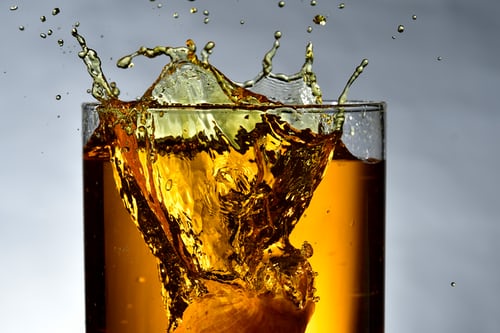Whisky Guide

There are not many drinks as complicated as whisky. Wine may be up there, but whisky in my book is a close second. There are so many different varieties and so many categories involved, that figuring it out is quite a challenge. Luckily for you, you have this guide to help you.
What is Whisky?
Whiskey is an alcoholic product made from grain and aged in wooden barrels (in the broadest terms.)
The location of production, type of grain used in the making (mash), water, distilling process, the type of barrel used during ageing and ageing period all play a role in determining the type and even naming of the whisky. This is similar to how barrels, grape types and wine blending play a role in the production of fine wine.
Which brings us to… Whisky or Whiskey?
Well this is easy, whisky (without the E) is the Scottish spelling and whiskey (with the E) is the Irish spelling. Simple. And then Canada and Japan went with the Scottish spelling and USA went with the Irish spelling and that’s that. When ordering spirits online in Kenya, you will often find that spelling can be either one. I, personally, use Whisky because the Scots made it first, so…
How is it made?
Whiskey is made using barley, rye, wheat and corn as the main grains. Newer distillers may experiment with other grain, but those are the main ones. The grain is ground down and mixed with water- this is called mash and the process is called mashing. It is this mashing that extracts soluble sugars from the grain. Different mashes will produce different tastes; malt whisky will have a lighter body and a sweeter flavour like caramel or toffee. Wheat whisky will have flavours of bread and honey. Corn whisky is known for being incredibly sweet, whereas rye whisky is spicy and dry. One can even use more than one grain in the production and this is called a mash bill. I can decide my mash bill will be 50% wheat, 30% malted barley, 10% rye and 10% corn. Or 100% malted barley.
This is similar to the process of blending simple wine and even fine wine. Instead of blending different grains, however, it’s about blending the different grape varieties to perfect the wine!
When using barley, a ‘pre-step’ comes before the mashing. This step is called malting.
Malting- The barley contains starch that needs to be converted to soluble sugars. For us to get the soluble sugars the barley is allowed to germinate in warm damp conditions. Once the barley starts to shoot, the process is stopped by drying in a large kiln using peat. The peat used can significantly impact the flavour of the final product.
What are the different kinds of Whisky and what do all those words mean?! AARRRGH!
Yes, I totally understand what you mean. I too used to bandy these words around with only a passing understanding of what they truly meant. But, after a lot of reading and research, I can take a stab at guiding you to having a deeper understanding. For this, you need to break it down into the different locales.
SCOTLAND
General take-home message: The most prestigious of all the whiskies. The first to do it. Their styles are extremely varied and are mostly acquired tastes; for the seasoned whisky drinker.
The term Scotch describes a whisky that mainly uses malted barley (malt). Scotch MUST be made in Scotland. It also has to be aged for a MINIMUM of 3 years in oak barrels. They typically use ex-bourbon casks for this. No additional flavours and sweeteners are allowed. This lack of additives and sweeteners really ensures for a quality product as most alcohol retailers would agree! It’s a pure and simple, but extremely flavoursome whisky.
Whisky types
Single malt Scotch – Made from malted barley and water + yeast in ONE SINGLE DISTILLERY in Scotland.
Blended Scotch – Made from only malted barley and water + yeast and sourced from DIFFERENT DISTILLERIES in Scotland.
OTHER SCOTTISH WHISKY- THE TERM SCOTCH IS NOT USUALLY APPLIED TO THESE
Can be made from grain such as wheat.
Single grain Scottish whisky = Made from barley + other grain + water + yeast in one single distillery in Scotland.
Blended whisky = Single malt + Single grain + water + yeast.
Blended grain whisky =one single grain + another single grain + water + yeast.
REGIONS OF SCOTLAND
You thought we were done with Scotland? Not yet!! Scottish whiskey is further divided into 6 regions. And each region carries unique characteristics. The regions are Highlands, Lowlands, Speyside, Islands, Islay and Campbelltown. Don’t worry we’re not going to get into this today!
It must be noted that any age statement on the bottle denotes the youngest whisky used in the product. Thus, a 12yr old blend has the youngest part of the mix being 12yr old; the rest of it may be 20 yr old.
IRISH WHISKEY (NOTE THE E)
General take home: ‘Easier to drink’ because of the fruit-forward flavours and, also, for their popular blending style. Great for novice whisky drinkers, and a popular spirit bought online in Kenya.
Irish whiskey must be produced in Ireland, North or South and must be aged for at least 3 yrs in wood barrels. – much like the fine wines of the world; it’s all in the ageing.
Single malt Irish whiskey = malted barley only + water + yeast in a pot still ONE SINGLE DISTILLERY.
Single Pot still whiskey = only barley (malted and non-malted) + water+ yeast in a pot still in ONE SINGLE DISTILLERY.
Grain whiskey = mixed grains + water + yeast in a column still.
Blended whiskey = a mixture of any of the above. This is the most popular style in Ireland and Jameson is a great example.
AMERICAN WHISKEY (Again Note the E)
General take home – Sweeter because of their use of corn.
Of note is that American whiskeys allow for the addition of artificial colours and flavours.
American whiskey can be made anywhere in the USA. There are three distinct versions of American whiskey that you are likely to encounter.
Bourbon – Can be made anywhere in the US although mostly made in Kentucky. Being made from a mash bill that is at least 51% corn, must be aged in new, charred oak barrels, and must be bottled at 40% abv or more. Bourbon (because of the corn mash) is usually sweeter than other types of whiskey and has a full-bodied mouthfeel. Although these spirits aren’t the top-seller in Kenya, more appreciation for Bourbon is immerging in countries outside of the US.
Tennessee whiskey – Must be made in TENNESSEE. Very similar to bourbon. The only differences between the two styles are that Tennessee Whiskey must, of course, be made in Tennessee, and it must also go through a process called the Lincoln County Process. The Lincoln Country Process is a filtering process where the whiskey is filtered through a thick layer of maple charcoal before it is put into a new charred oak barrel for ageing.
Rye whiskey – Can be made anywhere in the US and must contain a mash bill of at least 51% rye. This results in a spicier whiskey, and should be appreciated and sipped like a fine wine.
CANADIAN WHISKY
Must be made out of grain (any grain) in the country of Canada (anywhere in the country) with no less than 40% alcohol by volume, and aged 3 years in barrels. That’s it! Got to love those Canadians. So laid back!
JAPANESE WHISKY
And surprise! Japanese whisky simply means that it came from Japan and is made from grain that’s not rice. No regulation on barrel ageing, years matured or even flavouring. Japan might not be known for producing fine wines or other spirits, but they sure are making a mark for producing quality whiskies! You won’t commonly find their spirits in Kenya or other African countries, but they are rapidly growing their export market! So, all in good time!
